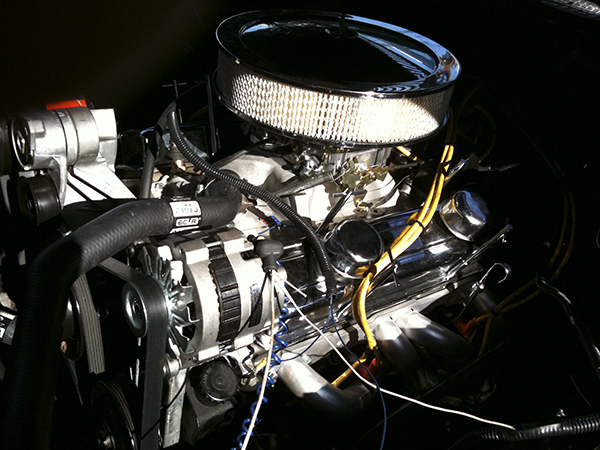Carburetor-Function
Smog Tech
Carburetor-Function

Smog Technicians learning about carburetors in the smog class for Engine Performance Class
Carburetor-Function
The Choke
The choke is a Carburetor-Function and sits on top of the carburetor its called the choke plate and its for cold starting, on a cold start, the choke must be close.
A cold car runs and starts better with a richer air/fuel mixture; this is the reason why the choke needs to be close in the morning.
The vehicle will experience a better start, prevents stalling and stumbling when cold.
Carburetor-Function
Venturi
In the main metering circuit within the carburetor, one of the Carburetor-Function is the venturi. This area creates the low-pressure air/flow that helps draw fuel through the carburetor's circuits.
Carburetor-Function
Transition Port
Another Carburetor-Function is the port above the throttle plate called the transition port. This port prevents hesitation on slow acceleration when the port becomes plugged.
Carburetor-Function
Accelerator Pump
The accelerator pump is another Carburetor-Function; there is another port above the throttle plate; this circuit helps prevent hesitation on hard acceleration.
Carburetor-Function
Float
The float is another Carburetor-Function, and in my opinion, it's an essential function. The float in the carburetor circuit will affect all other circuits.
If the float is either set too high or too low, it will affect every circuit in the carburetor, causing many different problems.
Problems as poor gas mileage poor performance, hard or no start can occur.
Carburetor-Function
Air Bleeds
Air Bleeds are significant to the flow of fuel and air. The air bleeds create an emulsified "liquid droplets of fuel that's mixed with air" air/fuel mixture to be delivered to the engine.
Carburetor-Function
Rich and Lean Air/Fuel mixture
A rich condition is an indication of too much fuel and not enough air. Anytime the carburetor is receiving a lack of air or too much fuel for any reason, this will create a rich condition.
If you have a carburetor running rough with a low RPM "let's say 600 RPM" and a rough idle create a vacuum leak.
If the RPM increases, let say the engine's RPM went up to 800 RPM's, this could indicate the vehicle is running rich.
A lean condition is an indication of too much air and not enough fuel. When the carburetor is receiving too much air and not enough fuel, this will create a lean condition.
If you have a carburetor running rough with a low RPM "let's say 600 RPM" and a rough idle and you add fuel or cut off the air flow.
Then the RPM increases, let say the engine RPM rises to 800 RPM's, this could indicate the vehicle is running lean.
Carburetor-Function
Choke Pull-Off
Another carburetor function is the cold start condition. We discuss this earlier, to start up a carburetor on a cold engine the choke needs to be close, but it can't stay completely close or the car will not start.
The choke pull-off is needed to partially open the choke, if the choke stays close the vehicle would have a hard start or no start when cold.
Carburetor-Function
Main Metering Circuit
The main metering circuit another carburetor function works at cruise speeds. The venturi creates a low-pressure area that helps increase the air and fuel through the main metering jets.
This will give a sufficient amount of fuel for higher speeds without causing a drive-ability concern.
Carburetor-Function
Power Circuit
If you are driving and trying to pass a vehicle on the highway, you will need the additional fuel when you stomp on the throttle plate, with the sudden rush of air the carburetor will need the fuel to match it.
This carburetor function is called the power circuit; it could be either a power valve or power jets to provide additional fuel for the incoming air for the increased power.
Carburetor-Function
Electronically controlled carburetor's
Before the age of electronic controlled carburetors, the carburetor's where mostly mechanical, when the introduction of electronic controlled carburetors, the air/fuel mixture is mostly controlled with mixture-controlled solenoids.
This carburetor function can control fuel only, air only or both air and fuel. This is a more precise controlled of the air/fuel mixture and better fuel economy.
What is a Carburetor
A carburetor is a device that mixes air and fuel for internal combustion engines in the proper air–fuel ratio for combustion.
CLASS SCHEDULES
Emission Control 1:
B.A.R. Smog Check
Inspector Level 1
(Inspector "Smog" License):
Engine Fundamentals
8am - 12:15 pm
Summer Class
7/5/2022 -8/5/2022
Class # 799065
Emission Control 2:
B.A.R. Smog Check
Inspector Level 2
(Inspector "Smog" License):
Rules and Regulations
8am - 12:15 pm
Summer Classes
7/5/2022 - 8/5/2022
Class # 799067
Engine Performance 1:
8am - 12: 15 pm
Date: TBD
Class # 799069
Engine Performance 2:
B.A.R. Specified Diagnostic
and Repair Training
(Repair "Smog" License)
Time: TBD
Date: TBD
Class # 799071
Emission Control 1
(Inspector "Smog" License):
5:00pm - 8:45 pm
Date: TBD
Class # 799065
Emission Control 2:
(Inspector "Smog" License):
5:00pm - 8:45 pm
Date: TBD
Class # 799065
Exhaust Emissions (Update Class):
5:30 pm - 8:45 pm
Tuesday nights:
Dates: coming soon
Class # 796070